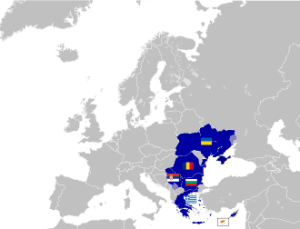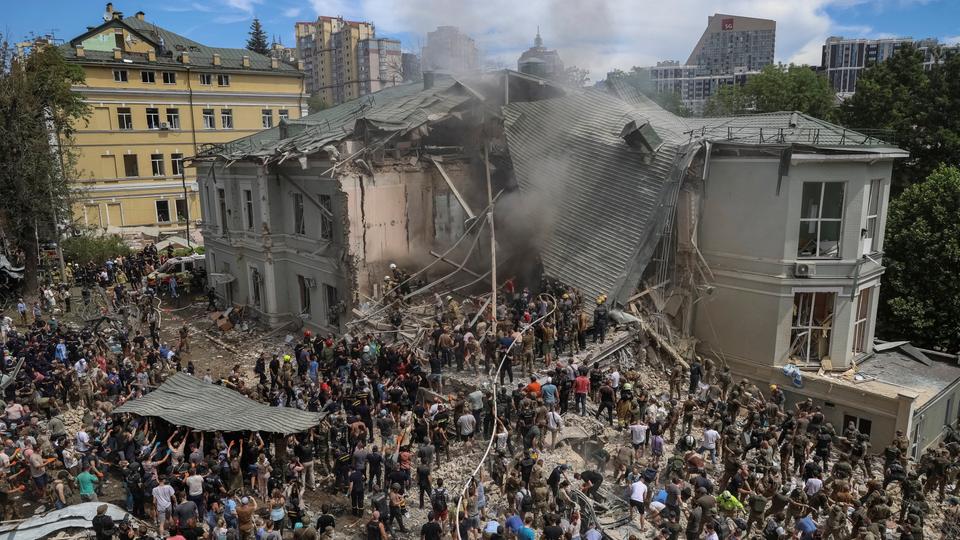Anyone who, based on past experience, might have anticipated the human sacrifice orchestrated to garnish the NATO meeting in Washington was not to be disappointed. The latest Russian rocket barrage on Ukrainian military and strategic targets, which occurred on the eve of the NATO summit in DC, presented an opportunity too precious to miss. Targeting only military or industrial sites would have done little to animate the NATO meeting or to get everyone onto the same page. But hitting a children’s hospital and killing some kids would be almost guaranteed to do the trick. Being in “total disarray,” as Alexander Mercouris bluntly put it, NATO could certainly benefit from this boost of adrenalin and whatever cohesive impulse dead children might provide to that ghastly organisation.
The Russian Government are not fools. They understand the game perfectly, and within hours the false flag in Kiev was irrefutably exposed. Their UN ambassador spelled the plot out in minute detail, for the benefit of the Security Council and anyone else in the “international community” disposed to listen.
The staged atrocity in Kiev is a technique that was elaborated to perfection in Sarajevo during the conflict in Bosnia in the 1990s. Whenever important Western visitors were scheduled to arrive or decisions deemed crucial to the interests of the Muslim-run Izetbegovic regime supported by Western powers were due to be taken, like clockwork a lethal event would be orchestrated for political and propaganda effect.
One of the most notorious, and without wishing to be blasphemous it could also accurately be said – iconic, incidents in this rubric was the Vaso Miskin Street massacre of people waiting in the breadline. It was staged by the local authorities on May 27, 1992 (also here). The timing was significant because at the end of May of that year a session of the UN Security Council was set to consider imposing draconian sanctions on the Federal Republic of Yugoslavia, to punish it for supporting their Bosnian compatriots. The massacre in which dozens perished was therefore staged right on cue, to give powerful “humanitarian” impetus to Security Council’s scheduled deliberations. It worked brilliantly and the sanctions were imposed. A series of similar false flag propaganda operations subsequently were organised at regular intervals, for the duration of the Bosnian conflict. Readers will recall the two Markale bombings in 1994, which followed exactly the same pattern, and there are other examples that could also be cited.
Readers may draw their own conclusions concerning the timing of the Kiev Children’s Hospital blast in relation to the NATO Summit being held in Washington, where the regimentation of member states behind the Ukraine war agenda without the slightest doubt is the predominant priority (see here).
One of the most noteworthy curiosities of this year’s NATO conference is the presence at the table of a very odd and by normal criteria least expected participant, Serbia.
The question that first comes to mind, of course, is what could possibly motivate militarily neutral Serbia to take part in the plenary conference of a military alliance of which it is not even a member, and which – for perfectly understandable moral and psychological reasons – over 90% percent of its population abhor, as the latest public opinion surveys clearly show? What business do the Serbian government have attending the 75th anniversary festivities of a military/political bloc with the evillest of reputations which, moreover, has treated Serbia with nothing but extreme violence and unambiguous contempt?
None whatsoever, of course, if the matter were to be judged by normal standards, which necessarily includes such basic things as respecting the unequivocal will of your constituents, adhering to the still binding neutrality law passed by your country’s Parliament, and last but not least evidencing due regard for the vital national interest of the nation that supposedly you are serving. But the aforementioned considerations form no part, even to the smallest degree, of the raison d’être which shapes the policies of Serbia’s duplicitous leadership.
Brown nosing NATO at its 75th anniversary is however only the latest, and the most blatant example of how the Serbian regime conducts its foreign relations. There are other examples which could also be cited.
Under the radar, on 8 November 2016 official Serbia, the one with NATO officers comfortably ensconced in its Army General Staff Headquarters, joined the Helbroc Balkan Battlegroup, a NATO combat outfit consisting of regional vassal states and Ukraine. Serbia has already participated in a number of Helbroc exercises, contributing for that purpose its military personnel and equipment.

Map showing Helbroc member states, including Serbia
The official mission of Helbroc forces is to serve as an urgent intervention unit. While deceptively portrayed as a European Union grouping, its agglomeration of forces consists of NATO member state personnel, with the sole exception of Ukraine and Serbia. Its units are subordinated to the command of officers from Greece, a NATO member state.
A review of the Helbroc accession agreement that Serbia signed reflects a commitment to execute “crisis management tasks” with other, mostly NATO, signatories within “and beyond” EU territory. That geographically open ended formulation is a red flag. It could justify the utilisation of Serbian armed forces in a wide variety of conflict situations having nothing to do with Serbia’s security or interests, subject to instructions issued by NATO military command structures to which the Helbroc Battle Group is clearly subordinated. Hypothetical combat use of this military formation against Russia can by no means be excluded.
As noted by retired Serbian Army colonel Žarko Pecić, Serbia’s participation in Helbroc is but a chard in a broader mosaic and should be assessed in conjunction with other significant steps which indicate the leadership’s determination to turn Serbia into a NATO member in all but the name, and perhaps ultimately in name as well. These steps have been the recent Platinum Wolf exercises, hosted partly on its soil by Serbia, with participation of units from NATO and NATO-associated countries, close military cooperation and procurement from NATO sources of weapons and military equipment, including helicopters and combat aircraft, signing in 2017 of the SOFA agreement granting NATO forces immunity on Serbian territory, and officer training in NATO member military schools. In the considered judgement of Col. Pecić, these activities in their totality reflect a purposeful design to bring the Armed Forces of Serbia closer to NATO and they indicate an undeviating process to ultimately integrate them into NATO structures.
In light of these facts, which until quite recently were discretely concealed from the general public, official Serbia’s presence at NATO’s Summit ceases to astonish.
Nor is there any reason to profess astonishment at recent revelations concerning the shipment of Serbian arms and munitions to the NATO-aligned Nazi junta in Ukraine. A treacherous pattern clearly has taken intelligible form and all the pieces of the unholy mosaic designed by renegades now fit naturally together. The only additional thing worth noting is that the stubborn unanimity the Serbian people have displayed in their support for Russia rests on a very solid foundation of fraternal attachment and gratitude. Throughout the nineteenth and twentieth centuries, Russians have generously spilt their blood for Serbia. Even the Serbian puppet government under Nazi occupation had summoned the courage to categorically reject German demands to send at least a symbolic detachment of Serbian soldiers to the Eastern front, which was an invitation to commit moral suicide on behalf of the entire Serbian nation. Shockingly, all that has now been reversed.
The use of Serbian military equipment in Ukraine has by now undoubtedly cost many Russian lives. But the Russian and international public need to understand that Serbia today is a mirror image of the broken Russia of the 1990s and that it is similarly governed by foreign agents who neither speak for the nation nor take its opinions into account.
Enough said for all who have eyes to see and ears to hear.
NATO war criminals and their Ukrainian Nazi minions may be a fitting social milieu for Serbia’s ruling clique. Maintaining cordial relations of any nature with them however leaves an unpardonable stain upon the honour of the Serbian people.



